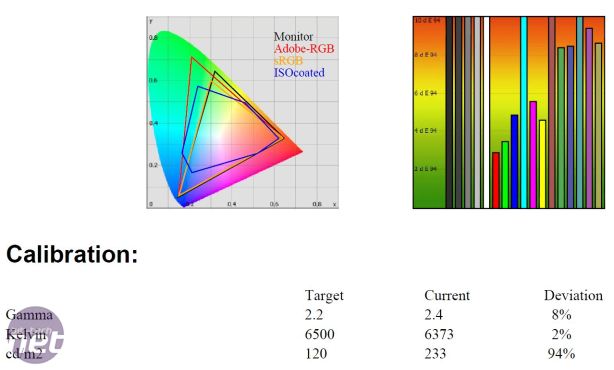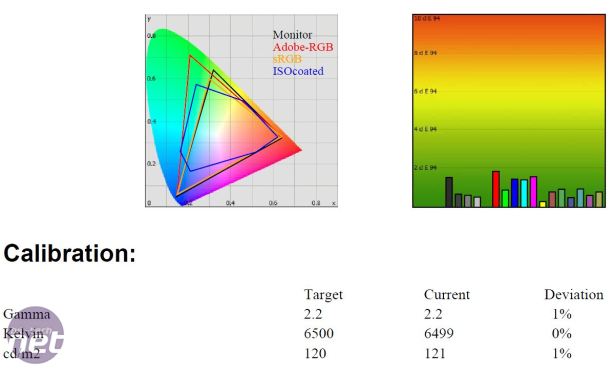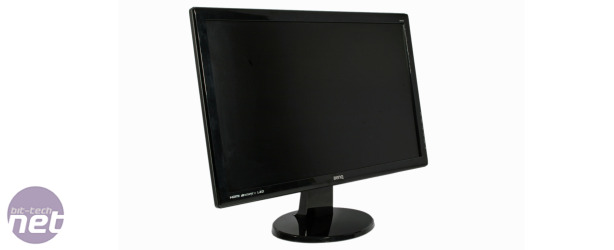
Image Quality
Out of the box, the GW2450HM produced reasonable, if not mind-blowing results. Using a DataColor Spyder calibration too, we measured its brightness in its Standard mode at 233cd/m2, its colour temperature at 6,373K (giving the image a slightly warm tint) and gamma levels at an overly high 2.4. The 9.3 dE94 suggested colour accuracy was far from ideal too.Calibration Report - Out of the Box

Switching to the pre-calibrated sRGB setting improved matters significantly, producing brightness readings of247cd/m2. A colour temperature of 6,510K is almost spot on and the gamma of 2.3 was only slightly higher than the 2.2 average we like to see. Colour accuracy also improved to a dE94 of 8.7, but this is still no-where near good enough for professional image editing. While we attempted to improve the matter via tweaking the panel via its OSD, this proved fruitless.
Calibration Report - SRGB

Calibration Report - Calibrated

Fully calibrated, the results were very impressive for such a budget panel. Images, videos and games all looked fantastic, with accurate colours, sharp edges and smooth motion. There were no noticeable leaks from the backlight in darker scenes of films, and dark images in general looked rich thanks to the AMVA panel.
One side effect of calibration is that we dropped the brightness significantly – this could prove problematic for some, as lowering the brightness below 100 per cent engages PWM backlight dimming, which can potentially create a flickering image if your eyes are sensitive enough. We didn't experience this issue, although if you think you are susceptible to it the only way to prevent it is to run the display at 100 per cent brightness and calibrate around that limitation.
To customise image quality without a calibrator you'll have to dive into the limited OSD, which is controlled using the five buttons on the right side of the display. It's easy enough to navigate once you realise the icons on the front of the bezel don't line up exactly with the buttons themselves, so where you should aim isn't necessarily where you would expect. Annoyingly the first menu tab is only used when connected over VGA, being greyed out and useless when connected over HDMI or DVI. It would have been much better if this was buried further into the menu system, rather than the first thing you see.
The much more useful picture settings give you control over brightness and contrast, five different gamma settings, individual RGB colour controls and an "AMA" toggle which controls the level of overdrive for gaming. Throughout our testing, there was little doubt that the "Premium" setting is the one to choose – it all but eliminates motion blur on the open source PixPerAn testing tool, which is an impressive feat for an AMVA panel. On the "High" setting there was some slight ghosting and the effect was visible to the naked eye with AMA switched off. There was a tiny amount of overshoot which doesn't occur on some of the IPS panels we've tested, but it's so slight that it was only visible when running tests designed to highlight the effect. With an average input lag of 6ms, it shouldn't present any problems for gaming, even for twitch-FPS players.
As you might imagine, the £142 GW2450HM isn't perfect - the weedy pair of 2w speakers built into the monitor are disappointingly poor, to the point that we question why BenQ included them in the first place. As we expect all our readers to be using headphones or dedicated speakers, this shouldn't be a deal breaker. Viewing angles aren't perfect either – it is the one area that AMVA panels still show their weaknesses in relation to IPS, and the GW2450HM is no different. We had no problems working at a face-on angle, but colours begin to appear washed out at more extreme horizontal angles. Out-of-the box colour accuracy is far from ideal as well, with a very high average de94 in comparison to a number of its competitors.
Conclusion
AMVA technology has come a long way in a short space of time, and BenQ has done well to get such a quality panel into the GW2450HM at this price. It's no rival for a jaw-dropping IPS display such as that wielded by the Dell U2412M though, and lacks the fantastic viewing angles and colour accuracy you'd get from opting for an IPS display. It's also not particularly adjustable without a colourimeter, and the plastic construction hardly screams quality. While it's image quality is strong in some respects, such as colour temperature and gamma, we'd still recommend heading down the IPS route, especially as prices have now come down below £150 for a similarly sized IPS panel.-
Performance31 / 40
-
Features22 / 30
-
Value23 / 30


MSI MPG Velox 100R Chassis Review
October 14 2021 | 15:04









Want to comment? Please log in.